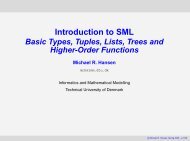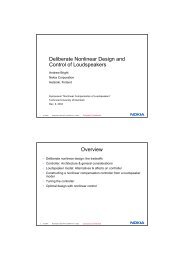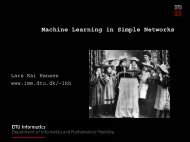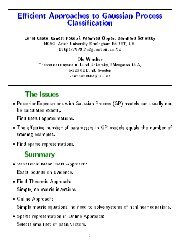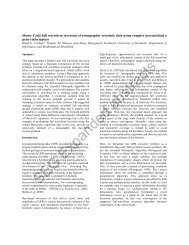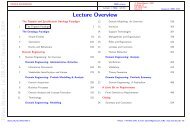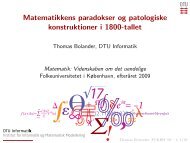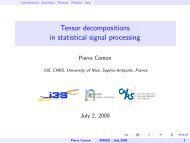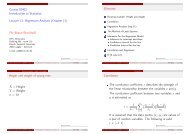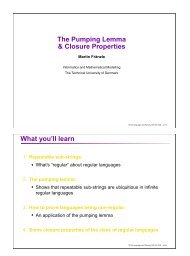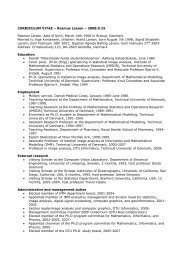Solutions for 02402 exam 15. December 20111
Solutions for 02402 exam 15. December 20111
Solutions for 02402 exam 15. December 20111
- No tags were found...
Create successful ePaper yourself
Turn your PDF publications into a flip-book with our unique Google optimized e-Paper software.
On a 5% significance level only one of the following options can be a critical value <strong>for</strong>a ”large sample” test of this hypothesis. Which one? We would use the test statisticgiven in page 284:14 − 2000 · 0.004Z = √ = 2.132000 · 0.004 · 0.996But actually we only need the one-sided critical value from the standard normal (Z)distribution to answer the question, and hence the correct answer is 4: z 0.05 = 1.645Question III.3 (9) We repeat the setup from the previous question: (hence one doesnot need to look at that again). Out of 2000 tested gaskets, a total of 14 was defective.The Chinese company guarantees that the error rate is not more than 0.4%, so thefollowing hypothesis test is per<strong>for</strong>med:H 0 : p = 0.004H 1 : p > 0.004The P-value <strong>for</strong> this test can be found using the binomial distribution as follows? (Xis now the number of defective out of 2000). Instead of using the (large sample) Z-testas in the previous question, we are now asked to consider the (exact) binomial basedP-value probability computation. Since a P-value is the probability of observing whatwe’ve seen or something more extreme it becomes:P − value = P (X ≥ 14) = 1 − P (X ≤ 13)where X follows a binomial with n = 2000 and p = 0.004. In R this number canbe found directly as 1-pbinom(13,2000,0.004) to achieve 0.03388445 and hence thecorrect answer is 1: P (X ≥ 14) = 0.034. (Without using R, answer option 2 canbe excluded either by noting that the binomial in question has mean np = 8, so theprobability of going beyond 13 could NOT be as large as 0.999, OR in more detail toapply the normal approximation of the binomial that would say the same thing)Exercise IVThe arrival of guests wishing to check into a hotel is assumed in the period between 14(2pm) and 18 (6 pm) o’clock to be described by a poisson proces (arrivals are assumedevenly distributed over time and independent of each other). From extensive previousmeasurements it has been found that the probability that no guests arrive in a periodof 15 minutes is 0.30. (P (X = 0) = 0.30, where X describes the number of arrivals per15 min).Question IV.1 (10) The expected number of arrivals per 15 min, and the probabilitythat in a period of 1 hour 8 guests or more arrive are? First we need to find theintensity λ 15min of the poisson distribution <strong>for</strong> X - we use the general expression <strong>for</strong>getting zero events in a poisson:P (X = 0) = λ0 15mine −λ 15min0!= e −λ 15min5



